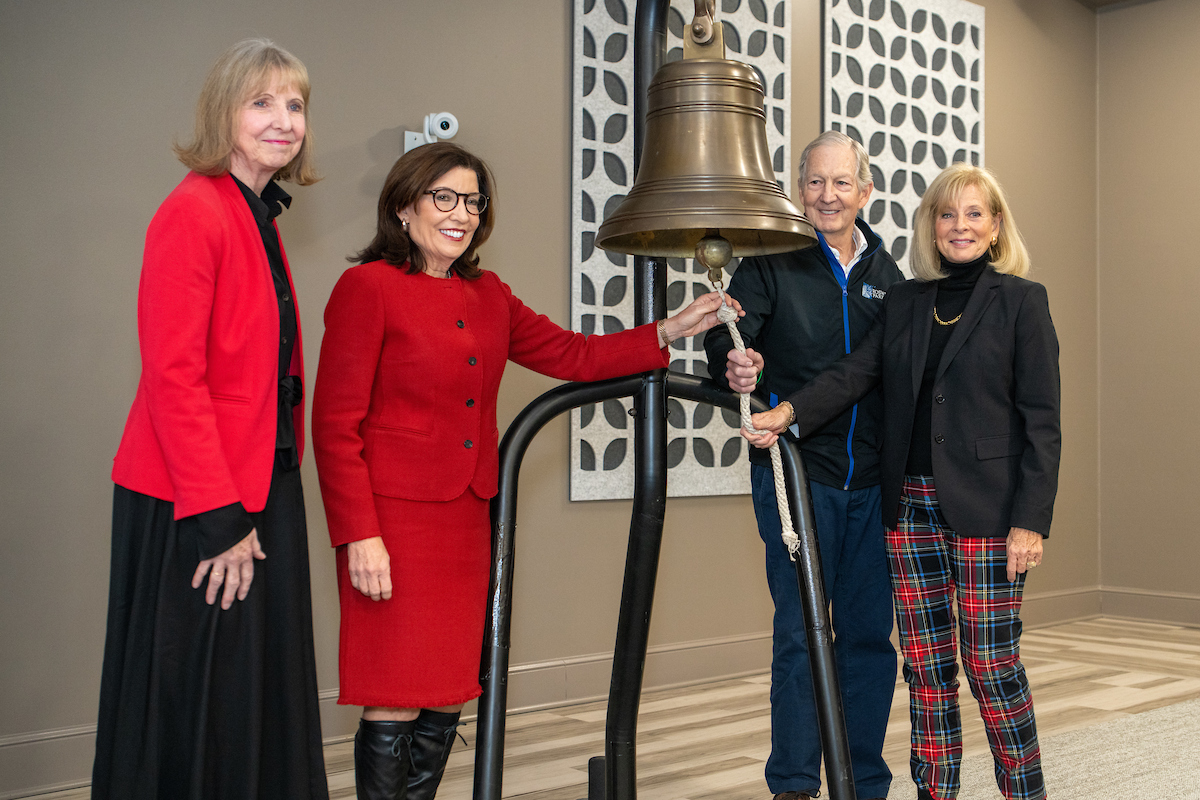The university’s How to Get to Cal State initiative is aimed at helping students from sixth to 12th grade explore the possibility of earning a college education and accessing the resources they need to get there. In addition, all 23 CSU campuses implement their own programs to support students from preschool to high school. Learn about some of them here.
Science for All
Founded by Humboldt State University students Christian Trujillo, Diana Martinez and Odalis Avalos in 2019, Ciencia Para Todos (Science for All) provides educational resources in Spanish for elementary, middle and high school students. The ultimate goal is increasing Latinx representation among college students and professionals in the scientific field.
“In a lot of our classes, we never really talked about working with individuals who spoke other languages,” says Trujillo, an environmental science and management senior. “But in our own experiences and identities, when we go back home to our families and our communities, it’s very different. We wanted to figure out how we could include our science and cultural identity at the same time.”
With an initial focus on dual immersion schools, the student team developed and led Spanish-language activities, especially around environmental science, for elementary classrooms. One taught the water cycle through dance while another taught pollination by having students act as bees “pollinating” flowers with pipettes.
They also developed partnerships with organizations—working on a wetlands education project with Latino Outdoors and the Northcoast Regional Land Trust and translating children’s resources on rainbow trout into Spanish for U.S. Fish and Wildlife Services.
“We want to change the narrative,” Trujillo says. “We want to show students they can be scientists, and they can be bilingual in their higher-educational selves and futures.”
Now, the team is assembling an elementary-level environmental science book featuring two learning sections and two activity sections using these resources. They hope to hand out the books to local students as well as to children in Spanish-speaking countries.
“We want to empathize and organize so we can help kids who don’t have iPads, who don’t have access to Wi-Fi on a daily basis, whose schools are not providing these resources,” says José Juan Rodríguez Gutiérrez, a wildlife biology management and conservation junior who recently joined the group. “They can view this information as something much more applicable to their personal surroundings, because these children are living in less-than-suitable environments—environments that are toxic from the pollution in the air, the trash around them and the lack of access to clean water.”
Going forward, they also want to introduce the in-person activities into more schools throughout California, include more languages and scientific topics and expand to other CSU campuses.
“We hear over and over and over, ‘You’re the future,’ and these kids are hearing that,” Rodríguez Gutiérrez says. “But when you don’t hear that in your language, you don’t know if you’re going to be part of that future. I believe letting these children know they can be whatever they want to be is the most valuable thing Ciencia Para Todos is trying to do—to encourage, empower and motivate.”
STEM Growth
The Center for Innovation in STEM Education (CISE) at California State University, Dominguez Hills promotes STEM education through teacher pathways and programs designed for K-12 students. For example, CISE hosts a day-long STEM in Action conference for 1,000 local students and STEEAM (science, technology, engineering, English language development, art, mathematics) Week, during which the campus’s mobile fabrication labs (fab labs) visit local schools to conduct nontraditional STEM activities in the classroom.
With the onset of COVID-19, CISE introduced new health education programs in partnership with Apple’s Taking Action on Racial Equity and Justice Learning Challenge Series specifically for vulnerable populations of students, like those experiencing homelessness or under foster care. This included redesigning STEEAM Week.
“The main purpose [of STEEAM Week] has always been to engage K-12 students in fun STEM activities to get them closer to the STEM fields, to feel an excitement about STEM and to be inspired to pursue STEM as a major at a CSU and maybe as a viable career choice,” says Kamal Hamdan, Ed.D., director of CISE. “But [this year, it was] rather to serve the purpose of helping our fellow human beings. That was what was powerful about this project.”
In conjunction with local schools, CISE worked with middle school students to design and 3D-print protective face shields using the mobile fab labs, develop public service announcements concerning the pandemic and write letters of encouragement to older adults living in the community. They then distributed packages consisting of face shields, hygiene kits and the letters to these adults.
“There was a big plan to offer support to the older adults who live in the city of Carson and have been experiencing isolation as a result of the pandemic,” Dr. Hamdan says. “We heard stories about how older adults have been living in isolation, and they don’t have the means to break down these barriers and be connected to the outside world.”
In addition, his team is recruiting 50 CSUDH students enrolled in CISE to provide online tutoring for K-12 students identified as potentially vulnerable at three elementary schools and one high school in Carson. Some CISE students will also provide technology support to the city’s older adults.
Hamdan hopes to recruit more CSUDH students outside CISE to be part of the tutoring program and expand the program to other CSU campuses.
“It’s a life-long worth of hurt, meaning it takes a lifetime for someone to recover from the impact of the pandemic on learning,” Hamdan says. “This program is a perfect match with the CSU spirit, and I see this continuing for a long time. As long as there are communities that are underserved, as long as there are students in these underserved communities not receiving high-quality instructional experience, I see this continuing. This should not end with the end of the pandemic.”
Art of Learning
With a new five-year grant, a team from California State University, Monterey Bay is launching a program to teach the children of Salinas farmworkers about environmental health using art and to inspire them to enter careers that address the health impacts of environmental challenges.
It’s based on the longitudinal Center for the Health Assessment of Mothers and Children of Salinas (CHAMACOS) study out of University of California, Berkley, created by epidemiological researchers Brenda Eskenazi and Asa Bradman, on the effects of pesticides and other environmental factors on farmworker families.
“We’re looking at how we can better educate and provide experiences that will enhance the opportunities of the young people growing up in this area, who may want to consider jobs that address environmental health, medicine or other STEM-related fields,” says Daniel Fernandez, Ph.D., professor in the Department of Applied Environmental Science.
The program will cycle each year through three areas of study—plastic pollution, climate change and agriculture—incorporating different forms of visual, media and theater arts.
“One of the opportunities of engaging students in hands-on project-based learning is they’ll have the opportunity to practice and think about effective ways to communicate to an external audience,” says Corin Slown, assistant professor of science education. “The goal is the students themselves will be agents of change as they both engage with the material and learn about and inform their communities.”
Currently, the team is recruiting 30 sixth-, seventh- and eighth-grade teachers who will be trained to introduce the educational materials into their classrooms. They’ll then work with art organizations Baktun 12—known for documentary theater—and Artists Ink, as well as students recruited through CHAMACOS, to develop the art curriculum, with Artists Ink developing a mobile application for the program. In addition, the Monterey Bay Aquarium will host a summer institute and winter and spring summits that reinforce the learnings.
“We have a diverse community here in Monterey County, and we have a growing Latinx population,” says Enid Baxter Ryce, professor of cinematic arts and technology. “We want to see that increase reflected in the fields of the sciences, to have more and more young folks feeling like the sciences are for them.”
The aim is also to create a lasting change in these schools’ curriculum. “The hope is this grant builds the teachers’ capacity so, as students generate ideas for continuing this work, that would be something that could be sustained well beyond the life of the grant,” Baxter Ryce says. “The hope is the teachers who participate become leaders in their own school districts or at their own school sites and are able to share the practices they develop in their own classroom with other teachers.”
Start Young
Some CSU programs focus on students even younger than kindergarten age. The Associated Students Children’s Center at California State University, Northridge offers child development services for children between the ages of 18 months and five years. Open to children of faculty, staff, students and the community, the program usually offers full-day, year-round care. But when the center closed for COVID-19 in March 2020, it switched to distance learning activities on Zoom, offering free 30-minute sessions in the morning and evening.
“It’s extremely important because we promote and foster the kids’ development holistically—math, language, science and even movement,” Center Director Klara Pakozdi says. “The kids are very lively, they interact, they participate, they ask questions, they are growing very confident very quickly—not only with the technology but interacting with their peers and their teachers.”
Implementing the Creative Curriculum Cloud for online learning, the center’s teachers are providing age-appropriate activities in math, science, storytelling, art and English language development, including English as a second language. Parents are also encouraged to participate. “Our goal is to make it very interactive and creative,” Pakozdi says.
Since going virtual, the program has attracted some new families. Pakozdi hopes the distance learning program will encourage parents to bring their kids to the in-person services once that’s again an option, as well as prepare the children for that return.
“We hope, when some of the children participating in our comprehensive distance learning activities return to face-to-face services, they will transition well with a good foundation,” she says.
Learn more about other programs for children and young adults at California State University Channel Islands, California State University, Dominguez Hills, Humboldt State University, California State University, Los Angeles, California State University, San Bernardino, San Diego State University and California Polytechnic State University, San Luis Obispo.




